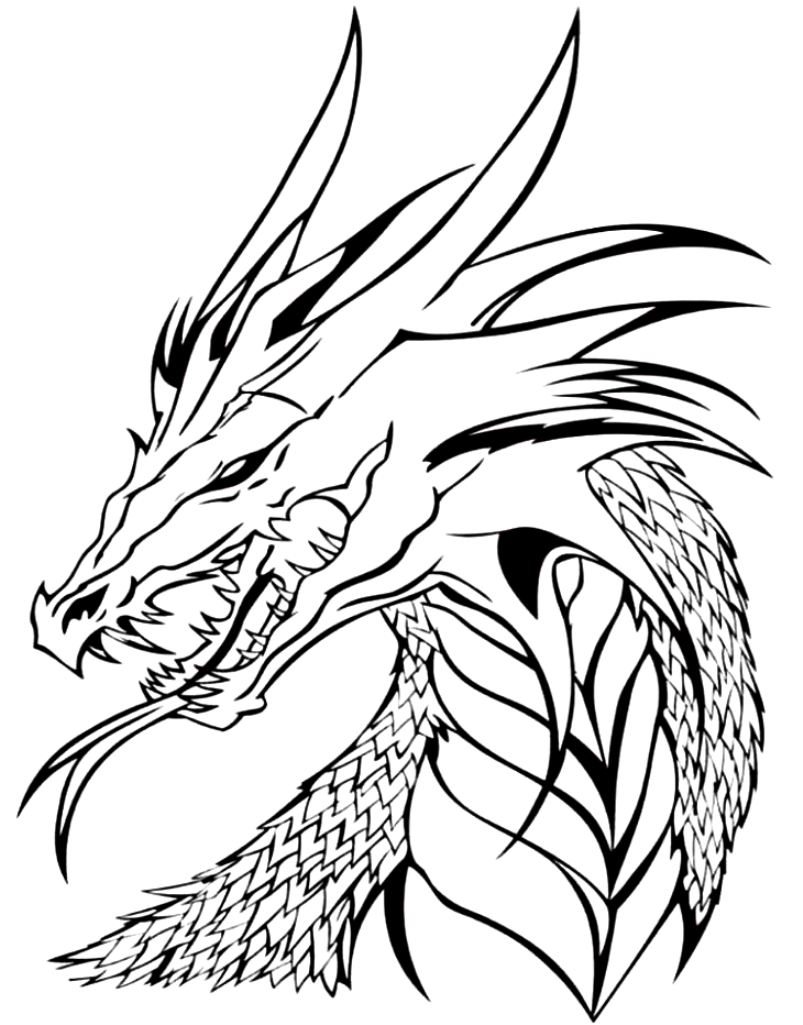Dragons
Dragon coloring pages will take you to a fantasy world. Dragons, which are depicted with dragon red, black and brown colors, are mythical creatures whose existence is not clearly known. The common motif of dragons in mythology is a creature with lion claws, snake tail, scaly skin, wings and fire. We have carefully selected our coloring pages for you. What you need to have; crayons in red, yellow, orange, black, blue, brown.
Dragons Coloring Pages (Free Printable)
The fact that even the documentaries of dragons, for which there is no clear data about them, are being made is proof of the deep belief in their existence. Unfortunately, almost all of the skeletons introduced as dragon skeletons belong to dinosaurs. Although it is often thought that dragons, like dinosaurs, lived for a certain time, the fact that they did not leave any traces raises a question mark in mind.
Dragons with a spiky tail and head have webbed wings. It has claws with huge claws and a skin that is too hard to inflict any damage. It is known that the tongues of dragons, which are sharp and have many teeth, are also quite long. Moreover, it is worth noting the fire-spraying properties that can go very far.
Characteristics of Dragons.
There are hundreds of scientists who say that fossils related to dragons are encountered when looking at the researches done on the world. However, the sages of the Far East also had dragons that their families claimed to have seen and trained. In the researches made by archaeologists and historians, statements were made that dragons lived on the summits of the mountains, in habitats that no one knew about.
Dragons, which are described as hot and angry creatures, have values that they represent. the dragon, which is defined in the west as anger, ugliness, restlessness and harm; In the east, it means wisdom, motherhood, independence.
It is seen that dragons, which are believed to be magical and spiritual beings, are depicted differently in many parts of the world. While a creature that does not have wings but breathes fire is drawn in eastern culture, it is seen flying in almost every drawing in western culture. With the common features, it is observed that especially the Chinese and Japanese cultures have more protection for dragons. The dragon, which is the symbol of many far eastern countries, is an entity carried up to the national flags.
In many drawings, 2-headed and 3-headed dragons can also represent enemies. It is possible to say that it is the epitome of hypocrisy. Although it is stated that the dragon is a symbol of bad luck in Europe, for the Far East, the dragon means liberation and freedom.
1. In China and South Asia, dragons are mythical creatures just like in the West. They are generally described in the form of four-legged snakes. Although they do not have imposing wings, they can glide through the air.
2. In the Far East, especially in China, the dragon has many positive meanings. It is a symbol of nobility, good luck, might, power and holiness.
3. In Chinese culture, there are everyday proverbs such as "Let your son be like a dragon". Some people strive to give birth to their children in the year of the dragon according to the Chinese calendar.
4. In ancient China, it was believed that rulers were descended from dragons. This image is the flag of the Qing Dynasty. It is said that Liu Bang, the founder of the Han Dynasty, became pregnant with his son after his mother dreamed of a dragon.
5. The dragon of the West has the power of fire, while the dragon of the East has the power of water. It doesn't spray fire, but it makes rain. It also lives in the depths of all kinds of water sources.
6. The dragon of the West is usually depicted in the form of a lizard or snake. It has huge wings and breathes fire in a terrifying fashion.
7. The dragon of the West represents a demonic evil. He is greedy. It lives in caves and nooks. He is a gold lover.
8. The Western dragon, which appears in many fairy tales, fantasy stories and even religious stories, is an evil creature that must be defeated. It prevents the prince from reaching the princess. He is the devil himself.
9. In the West, the dragon is compared to a "serpent" in many sources, and according to Christian stories, it is a "serpent" that seduces Eve. The cult of the snake coincides with the fear of dragons.
10. In the "Book of Revelation", one of the chapters of the New Testament, Satan is depicted as "a dragon with a fiery red, seven heads and ten horns".
11. Dragons of the East are friendly to man and are known as the source of man, but the dragon of the West is a fierce enemy of man. It harms him, it misleads him.
12. In Western fiction, Le Guin, who is highly influenced by the teachings of the East, breaks the habit of the evil dragon. Le Guin's dragons hold ancient knowledge and genuine language.
13. Le Guin's dragons, like Tolkien's Smaug, spread fear and menace with Western influence. But they are also wise and noble, like the Eastern dragons.
Almost everyone who believes that dragons do not exist, so what is their role in nature? is asking the question. It is possible to say that each animal has a distribution of duties on the ecological system. Dragons, on the other hand, have not been placed on an ecological mission in nature. The main reason for this is that they act as protectors in wars in almost all paintings and narratives. In this context, it is possible to say that the main task of the dragon is to protect human beings.












